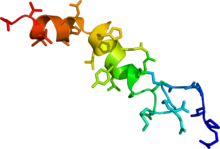User:Mr. Ibrahem/Narcolepsy
| Narcolepsy | |
|---|---|
 | |
| The concentration of orexin-A neuropeptides in the cerebrospinal fluid of narcoleptic individuals is usually very low | |
| Pronunciation | |
| Specialty | Sleep medicine, neurology |
| Symptoms | Excessive daytime sleepiness, involuntary sleep episodes, sudden loss of muscle strength, hallucinations[1] |
| Complications | Motor vehicle collisions, falls[1] |
| Usual onset | Childhood[1] |
| Duration | Long term[1] |
| Causes | Unknown[1] |
| Risk factors | Family history, brain injury[1] |
| Diagnostic method | Based on the symptoms and sleep studies[1] |
| Differential diagnosis | Sleep apnea, major depressive disorder, anemia, heart failure, drinking alcohol, not getting enough sleep[1] |
| Treatment | Regular short naps, sleep hygiene[1] |
| Medication | Modafinil, sodium oxybate, stimulants, antidepressants[1] |
| Frequency | 0.2 to 600 per 100,000[2] |
Narcolepsy is a long-term neurological disorder that involves a decreased ability to regulate sleep-wake cycles.[1] Symptoms often include periods of excessive daytime sleepiness and brief involuntary sleep episodes.[1] About 70% of those affected also experience episodes of sudden loss of muscle strength, known as cataplexy.[1] These experiences can be brought on by strong emotions.[1] Less commonly, there may be vivid hallucinations or an inability to move (sleep paralysis) while falling asleep or waking up.[1] People with narcolepsy tend to sleep about the same number of hours per day as people without, but the quality of sleep tends to be lessened.[1]
The exact cause of narcolepsy is unknown, with potentially several causes.[1][3] In up to 10% of cases, there is a family history of the disorder.[1] Often, those affected have low levels of the neuropeptide orexin, which may be due to an autoimmune disorder.[1] Trauma, infections, toxins or psychological stress may also play a role.[1] Diagnosis is typically based on the symptoms and sleep studies, after ruling out other potential causes.[1] Excessive daytime sleepiness can also be caused by other sleep disorders such as sleep apnea, major depressive disorder, anemia, heart failure, drinking alcohol and not getting enough sleep.[1] Cataplexy may be mistaken for seizures.[1]
While there is no cure, a number of lifestyle changes and medications may help.[1] Lifestyle changes include taking regular short naps and sleep hygiene.[1] Medications used include modafinil, sodium oxybate and methylphenidate.[1] While initially effective, tolerance to the benefits may develop over time.[1] Tricyclic antidepressants and selective serotonin reuptake inhibitors (SSRIs) may improve cataplexy.[1]
Estimates of frequency range from 0.2 to 600 per 100,000 people in various countries.[2] The condition often begins in childhood, with males and females being affected equally.[1] Untreated narcolepsy increases the risk of motor vehicle collisions and falls.[1]
References[edit]
- ^ a b c d e f g h i j k l m n o p q r s t u v w x y z aa ab ac ad "Narcolepsy Fact Sheet". NINDS. NIH Publication No. 03-1637. Archived from the original on 27 July 2016. Retrieved 19 August 2016.
- ^ a b Goswami M, Thorpy MJ, Pandi-Perumal SR (2016). Narcolepsy: A Clinical Guide (2nd ed.). Springer. p. 39. ISBN 9783319237398. Archived from the original on 23 August 2016. Retrieved 19 August 2016.
- ^ "Narcolepsy Information Page". NINDS. Archived from the original on 7 January 2017. Retrieved 7 January 2017.
